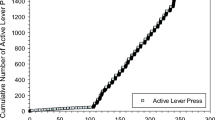Abstract
In order to assess the resistance of drug discriminative responding to prolonged reinforcement omission, rats were trained to discriminate between either 6.0 mg/kg PO or 30.0 mg/kg PO. CDP and saline, using a food reinforced (VI40-FR10) operant procedure. Dose generalization tests were conducted for both groups. Sessions were then run without reinforcement while drug (D) and saline (S) administrations were continued (extinction phase). After a maximum of 30 sessions without reinforcement, or when the rats emitted less than ten responses on either lever during three successive sessions (extinction criterion), reinforcement was reinstated. Finally, additional dose generalization tests with CDP were run. The discriminative responding controlled by the D and S administrations was not affected significantly by prolonged reinforcement omission in either group. For both groups, response rates were decreased and latencies to initiate responding were increased during the extinction phase. Response rate reduction occurred more rapidly for the drug condition in the high training dose group. This group also reached the extinction criterion sooner than the low training dose group. The reacquisition process occurred very rapidly. Response rates increased substantially after the first reinforcement had been obtained. After ten reacquisition sessions, response rates and latencies had reached values similar to those observed before extinction was initiated. Data revealed no differences between groups and the course of reacquisition did not differ between the S and D conditions. The generalization tests executed before the extinction phase and after the reacquisition phase yielded similar results and were in agreement with earlier findings. The major conclusion was that the resistance to extinction of the discriminative accuracy was substantial.
Similar content being viewed by others
References
Colpaert FC, Balster RL (eds) (1988) Transduction mechanisms of drug stimuli. Springer, Berlin Heidelberg New York
Colpaert FC, Niemegeers CJE, Janssen PAJ (1980) Factors regulating drug cue sensitivity: The effects of training dose in fentanyl-saline discrimination. Neuropharmacology 19:705–713
De Vry J, Slangen JL (1986) Effects of training dose on discrimination and cross generalization of chlordiazepoxide, pentobarbital and ethanol in the rat. Psychopharmacology 88:341–345
Emmett-Oglesby MW, Lal H, Bennet DA (1989) Stimulus properties of drugs: proceedings of the 1988 international meeting. Drug Dev Res 16:vii-ix
Ferster CB, Skinner BF (1957) Schedules of reinforcement. Appleton-Century-Crofts, New York
Harris RT, Balster RL (1971) An analysis of the function of drugs in the stimulus control of operant behavior. In: Thompson T, Pickens R (eds) Stimuli properties of drugs. Appleton-Century-Crofts, New York, pp 111–132
Heinemann EG, Sage-Day J, Brenner N (1981) Retroactive interference in discrimination learning. Science 214:1254–1257
Järbe TUC (1989) Discrimination learning with drug stimuli: methods and applications. In. Boulton AA, Baker GB, Greenshaw AJ (eds) Neuromethods, vol 13: Psychopharmacology. Humana Press, Clifton, New Jersey, pp 513–563
Järbe TUC, Swedberg MDB (1982) A conceptualization of drug discrimination learning. In: Colpaert FC, Slangen JL (eds) Drug discrimination: applications in CNS pharmacology. Elsevier Biomedical Press. Amsterdam, pp 327–341
Järbe TUC, Hiltunen AJ, Swedberg MDB (1989) Compound drug discrimination learning. Drug Dev Res 16:111–122
Koek W, Slangen JL (1982) Effects of reinforcement differences between drug and saline sessions on discriminative stimulus properties of fentanyl. In: Colpaert FC, Slangen JL (eds) Drug discrimination: applications in CNS pharmacology. Elsevier Biomedical Press, Amsterdam, pp 343–354
Overton DA (1988) Similarities and differences between behavioral control by drug-produced stimuli and by sensory stimuli. In: Colpaert FC, Balster RL (eds) Transduction mechanisms of drug stimuli. Springer, Berlin Heidelberg New York, pp 177–198
Sanger DJ (1987) Effects of drugs on schedule-controlled behavior. In: Greenshaw AJ, Dourish CT (eds) Experimental psychopharmacology. Humana Press, Clifton, New Jersey, pp 213–261
Spear NB, Smith GJ, Sherr A, Bryan RG (1979) Forgetting of a drug-conditional discrimination. Physiol Behav 22:851–854
Author information
Authors and Affiliations
Rights and permissions
About this article
Cite this article
Rijnders, H.J., Järbe, T.U.C. & Slangen, J.L. Extinction and reacquisition of differential responding in rats trained to discriminate between chlordiazepoxide and saline. Psychopharmacology 102, 404–410 (1990). https://doi.org/10.1007/BF02244111
Received:
Revised:
Issue Date:
DOI: https://doi.org/10.1007/BF02244111




